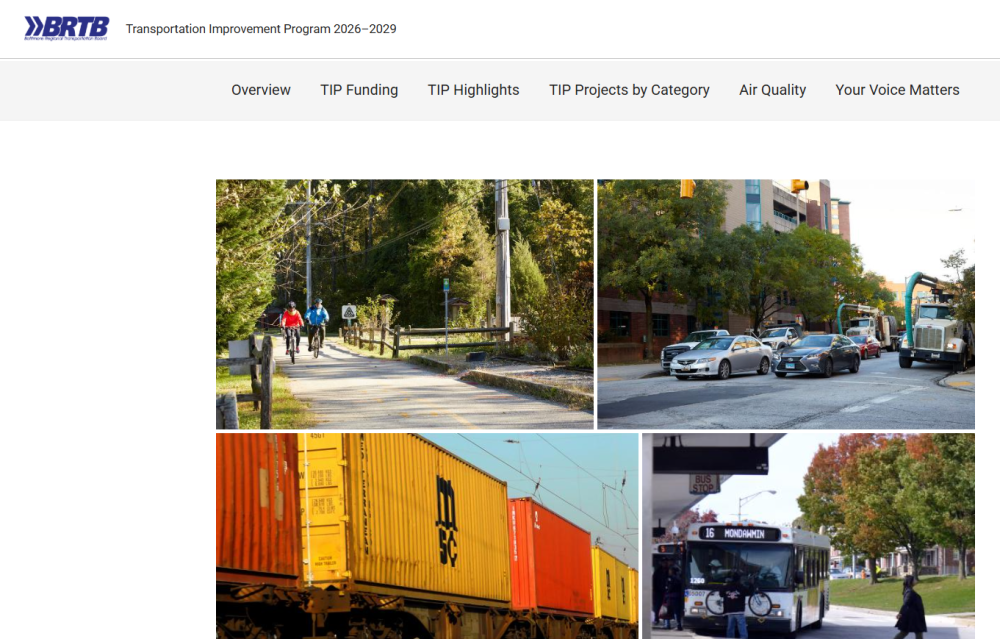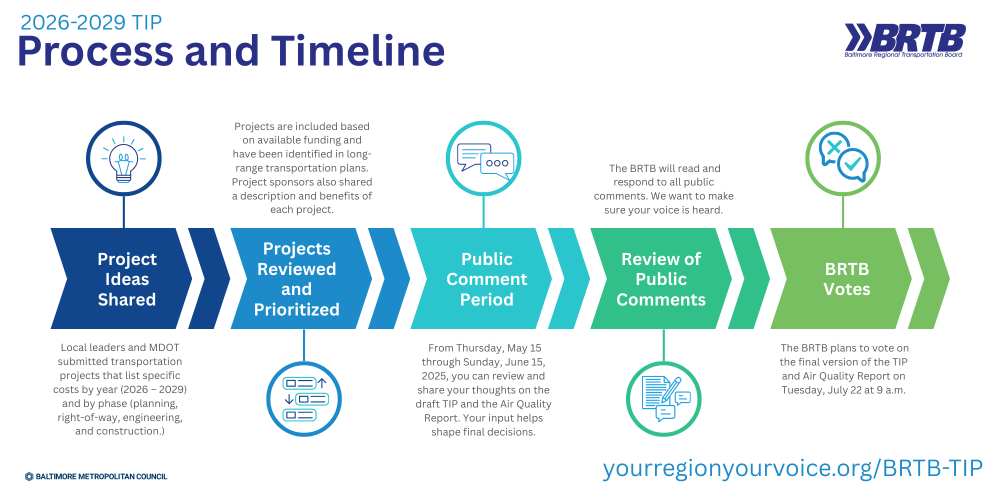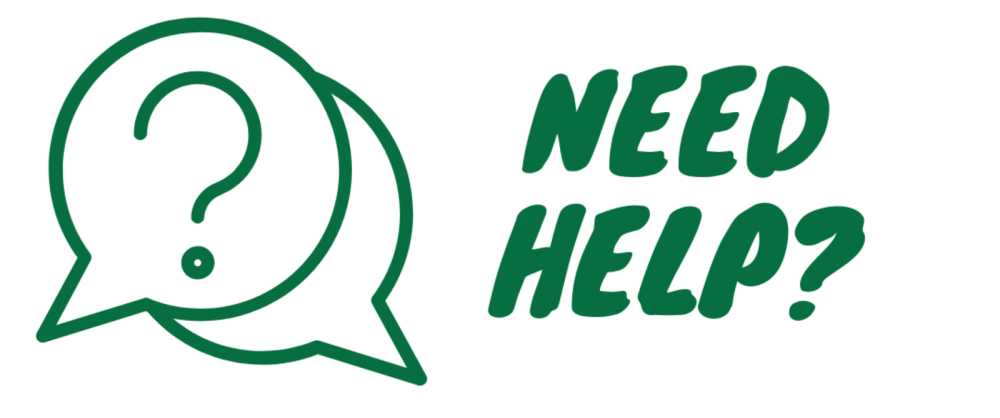2026-2029 Transportation Improvement Program (TIP)
2026-2029 Transportation Improvement Program (TIP)
The Baltimore Regional Transportation Board has put together a $6.2 billion strategy to improve how we get around over the next four years. This includes 172 projects—everything from new bike lanes and better sidewalks to upgraded transit, safer bridges, and smoother highways.
Want to see what’s coming? Explore our interactive StoryMap or download the full list of projects below. You can also check out how these projects may affect air quality.
We want to hear from you! The BRTB is now accepting public comments on the draft 2026–2029 Transportation Improvement Program and its Air Quality Assessment through Sunday, June 15.
What Is the TIP and Why Does It Matter?
The Transportation Improvement Program (TIP) is how we turn big transportation goals into real projects that get built. We take long-term transportation ideas—things we hope to do over the next 20 years—and turn them into a list of projects we can start now.
Think of it like a to-do list for improving transportation over the next four years. There are plans to fix bridges and roads, add new transit options, and make walking and biking safer. This includes big projects, like replacing the Key Bridge. It also includes small fixes and safety upgrades.
The TIP also shows where the money for these projects will come from. In our region, we get money from local, state, and federal governments. We also include toll revenue. It’s like a budget for making these improvements happen.
What’s in this year’s TIP?
The draft TIP includes 172 projects worth around $6.2 billion in investments.
This includes everything from new bike lanes and better sidewalks to upgraded transit, safer bridges, and smoother highways.
Want to see what’s coming? See highlights of the projects on the next tab! Then, take our survey and let us know what you think.
You can also:
Explore our interactive StoryMap
Watch a recorded overview (coming soon!)
Check out Our StoryMap
Ready to dive in deeper? View our StoryMap
Listen or Watch this Recorded Overview
Timeline
Timeline infographic showing the process for the 2026–2029 Transportation Improvement Program (TIP). It includes five stages: (1) 'Project Ideas Shared' – local leaders and MDOT submit transportation projects with cost details and descriptions; (2) 'Projects Reviewed and Prioritized' – projects are selected based on funding and long-range plans; (3) 'Public Comment Period' – runs from May 15 to June 15, 2025, inviting community feedback on the draft TIP and Air Quality Report; (4) 'Review of Public Comments' – BRTB reads and responds to public input; (5) 'BRTB Votes' – the final TIP and Air Quality Report are scheduled for a vote on July 22, 2025, at 9 a.m. The graphic provides the URL yourregionyourvoice.org/BRTB-TIP
See highlights on the projects on the next tab. Then, let us know what you think by taking our survey!
Need help? Email BRTB-TIP@publicinput.com or leave a voicemail at 855-925-2801 x 11470.
Frequently Asked Questions
The Baltimore region includes Baltimore City, Anne Arundel County, Baltimore County, Carroll County, Harford County, Howard County, and Queen Anne’s County. Approximately 2.8 million residents live in the Baltimore region, the 20th most populated Metropolitan Statistical Area in the United States, according to the U.S. Census Bureau.
The Baltimore Metropolitan Council (BMC) is a group of trusted experts who help guide the future of the Baltimore region. We evaluate needs and trends, listen to communities, and develop and implement programs and projects. BMC’s Board of Directors governs the agency and sets our policy agenda. BMC’s staff convenes elected officials, state and local agency specialists, and regional leaders to advance shared priorities in transportation, housing, workforce development, emergency management and more. Through our work, we are committed to making our communities livable, accessible and prosperous for all. For more information, please visit www.baltometro.org.
The Baltimore Regional Transportation Board (BRTB) is the federally designated metropolitan planning organization for the Baltimore region. Staffed by the Baltimore Metropolitan Council, board members include local elected officials as well as local, state and federal agency specialists who guide transportation planning and budgeting. We evaluate needs and trends, listen to communities, and advance shared priorities for the movement of people and goods throughout the Baltimore Region with a focus on safety, equity and resilience. For more information, please visit www.baltometro.org/BRTB.
BRTB members work locally to identify project ideas. Then, they share these projects with BMC staff. BMC reviews all of the project's funding, how it will affect air quality, and more. After that, we connect with community members like you to see what you think. Be sure to visit the Share Your Thoughts and Survey tab to let us know!
Most of the money, about 52%, comes from the federal government, totaling $3.2 billion.
MDTA Toll Revenues make up 30%, or $1.89 billion.
State and local funds make up 17% of the funding, which is about $1.09 billion.
We recognize the importance of safe and accessible active transportation options. We have pots of money called “Areawide Programs” that set aside funding for bicycle and pedestrian projects. In addition, major projects such as MD 175, MD 173 Bridge Replacement, Putty Hill Avenue over I-695 and MD 91 Bridge Replacement include bicycle compatibility features.
Additionally, to help us develop a strong network of bicycle paths, the BRTB is creating the first bike network for the Baltimore region. The Bikeable Baltimore Region (BBR) project aims to create a safe and accessible bike network for the entire region. Stay tuned to yourregionyourvoice.org/BikeBaltoRegion to learn more and get involved.
Safety now plays a bigger role in choosing projects. There are many safety-related projects such as fixing transit vehicles.
Plus, Complete Streets focus on designing roads for everyone, not just cars. These kinds of safety projects include:
- Making roads safer for people who are driving or walking.
- Adding bike lanes along roads and bridges.
We join forces with the Highway Safety Office at the Maryland Department of Transportation Motor Vehicle Administration. Together, we aim to make our roads safer. They have funded a safety planner job at BMC. They help make safety plans for local communities.
With help from the same safety office, BMC also runs the Look Alive campaign. This campaign shows people how to stay safe when walking or biking. You might have seen Signal Woman, the campaign’s superhero, sharing safety tips. The campaign is now growing to include all kinds of transportation safety messages.
BRTB members are involved in a variety of projects that help reduce air pollution.As funding permits, MTAwill purchase electric buses and hopes to test buses powered by hydrogen fuel cells in the near future. Other technology upgrades include better traffic signal timing and switching to energy-efficient LED lighting. There are also many improvements being made to sidewalks and bike lanes.
A new federal program is available to provide more funding for these types of efforts.
Email us at BRTB-TIP@publicinput.com or leave us a voicemail at 855-925-2801 x 11470.
Want to know more?
Check out previous TIPs and see results of previous comment periods at publicinput.com/baltoregiontip



